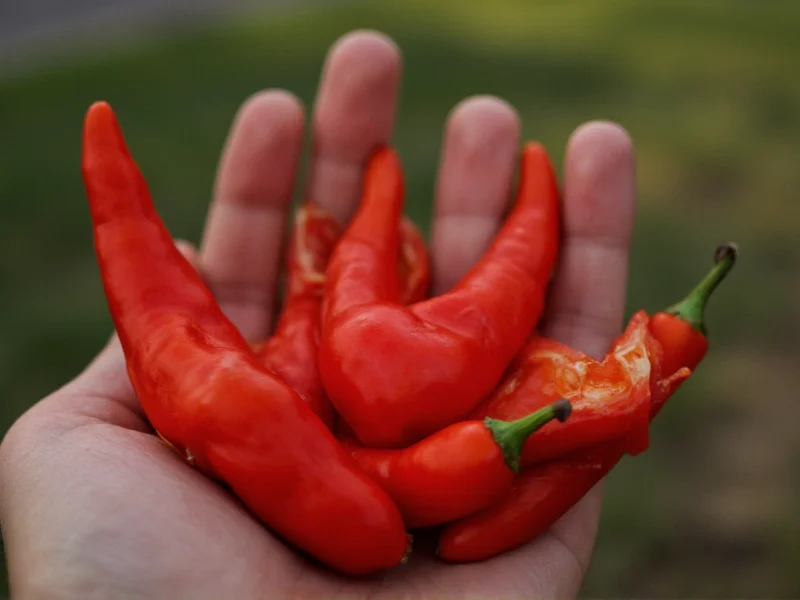Understanding the precise heat measurement of chili peppers helps home cooks and culinary professionals select appropriate ingredients for their recipes. The Scoville scale, developed by pharmacist Wilbur Scoville in 1912, remains the standard measurement for quantifying capsaicin concentration—the compound responsible for a pepper's heat.
What Determines Serrano Pepper Heat Levels
Serrano peppers (Capsicum annuum) maintain their characteristic heat range regardless of color. When serrano peppers mature from green to red, they develop sweeter, fruitier flavor notes while retaining the same fundamental heat profile. Environmental factors including soil composition, climate conditions, and water availability can cause natural variation within the established Scoville range.
Comparing Red Serrano Peppers to Other Common Varieties
Understanding where red serrano peppers fall on the Scoville scale provides valuable context for recipe development and heat management:
| Pepper Variety | Scoville Heat Units (SHU) | Relative Heat Comparison |
|---|---|---|
| Red Serrano Pepper | 10,000-23,000 | Base comparison |
| Jalapeño | 2,500-8,000 | 3-9 times milder |
| Cayenne | 30,000-50,000 | 1.5-2 times hotter |
| Habanero | 100,000-350,000 | 5-15 times hotter |
| Thai Bird's Eye | 50,000-100,000 | 3-8 times hotter |
Characteristics of Ripe Red Serrano Peppers
As serrano peppers mature from green to vibrant red, they undergo several changes beyond color:
- Flavor profile: Develops from grassy and vegetal (green) to fruitier and slightly sweeter (red) while maintaining crisp texture
- Size: Typically 1-3 inches long with a smooth, thin skin and tapered shape
- Harvest timing: Red serranos have been allowed to fully ripen on the plant, which can affect flavor complexity without increasing heat
- Storage: Red serranos maintain freshness for 1-2 weeks refrigerated or can be dried, pickled, or frozen for extended use
Practical Applications in Cooking
Chefs and home cooks utilize red serrano peppers for their balanced heat and flavor profile. The consistent heat level of red serrano pepper Scoville measurements makes them reliable for recipe development. Common culinary applications include:
- Creating vibrant salsas where the red color enhances visual appeal
- Adding controlled heat to guacamole without overwhelming avocado's delicate flavor
- Infusing oils or vinegars for salad dressings and marinades
- Preparing traditional Mexican dishes like pico de gallo and chiles en nogada
- Blending into creamy sauces where the fruitiness complements dairy elements
When working with red serrano peppers, always wear gloves during preparation and avoid touching your face. The capsaicin concentration in serrano pepper Scoville units can cause significant irritation to sensitive areas. Remove seeds and white membranes for reduced heat while maintaining flavor.
Growing Red Serrano Peppers
Gardeners cultivating serrano peppers should note that the transition from green to red occurs when peppers remain on the plant past their typical harvesting stage. This extended ripening period:
- Requires approximately 80-100 days from planting to full red maturity
- Benefits from consistent watering and well-draining soil
- Produces peppers with slightly higher sugar content while maintaining the characteristic serrano pepper heat level
- Results in thinner-walled peppers compared to jalapeños, making them ideal for fresh applications rather than canning
Safety Considerations with High-Heat Peppers
Understanding the red serrano pepper Scoville measurement helps prevent uncomfortable culinary mishaps. When handling these moderately hot peppers:
- Always wash hands thoroughly with soap after handling, especially before touching eyes or face
- Consider using kitchen gloves during preparation
- Neutralize accidental burns with dairy products like milk or yogurt, not water
- Start with smaller quantities in recipes, as heat perception varies among individuals
- Remember that cooking doesn't eliminate capsaicin—it redistributes throughout the dish
Common Misconceptions About Pepper Heat
Several myths persist about chili pepper heat that deserve clarification:
- Color equals heat: Red serrano peppers aren't hotter than green ones—they've simply ripened further
- Seeds create heat: While seeds carry some capsaicin, the highest concentration resides in the white pith membranes
- Heat indicates quality: Pepper heat varies naturally and doesn't correlate with freshness or flavor quality
- All serranos are identical: Individual peppers can vary significantly within the established Scoville range











 浙公网安备
33010002000092号
浙公网安备
33010002000092号 浙B2-20120091-4
浙B2-20120091-4